On my final evening in Osaka, I sat in a cafe along the Dotombori river A cold Asahi beer to my right and a searing hot plate of takoyaki sat before me. I was exhausted, hungover, stuffed, fat and content. During my 10 night Japan adventure I had overeaten, overspent and under-slept and yet, given the option, would've jumped at the opportunity to spend another 10 nights in the 'Land of the Rising Sun."
 When I arrived in Osaka on a Friday afternoon the weather was a cool 4 degrees. The temperature was a shock to my Taipei acclimatization and unbeknownst to me was only a prologue to the sub-zero temperatures I would endure over the following few days.
When I arrived in Osaka on a Friday afternoon the weather was a cool 4 degrees. The temperature was a shock to my Taipei acclimatization and unbeknownst to me was only a prologue to the sub-zero temperatures I would endure over the following few days.
The hostel which I had booked, at an extremely reasonable rate of $15 dollars provided me with a small, but private, unheated room in an older run-down Osaka neighborhood. I later learned that the Shinsekai neighborhood in which I stayed was known to be Japan's most crime ridden, although crime rates are well below those of any sizable western city. I found it to be a great place to stay as it was conveniently close to several train lines and had a grimy appeal that I had previously not experienced in Japan.
Shinsekai is an entertainment district which was the location of a famous amusement park 100 years ago. While it's most definitely seen better days, the neighborhood still has it's own attractions such as its centerpiece, the Tsutenkaku tower. The neighborhood is also renowned for one of Osaka's culinary specialties; Kushi-katsu.
Kushi-katsu is a breaded and deep-fried skewer of meat or vegetables, or really anything edible that can be pierced with a stick. The skewers are popularly dunked in a bath of tonkatsu sauce, invariable labelled with "no double dipping" labels to inform the stupid tourists. You can't really go wrong with deep-fried anything on a stick and I found Kushi-katsu to be expectantly delicious.
After a pint of local draught and a greasy meal, I spent my first evening in Japan bearing the sub-zero temperatures and crawling from pub to pub in Osaka's epileptic seizure inducing Dotombori district.
Dotombori is the feather in Osaka's touristic cap that shines after nightfall in the glow of neon signs. Dotombori also is the preeminent destination for sampling some more of Osaka's culinary delights.
Osaka's food culture is characterized by the Japanese word "Kuidaore," which literally means "to ruin oneself by extravagance in food", a phrase which I did my best to embrace throughout my stay in Japan. What better food to embrace Kuidaore than Osaka's regional specialties of takoyaki and okanomiyaki.
Takoyaki is a street-side snack of undercooked pancake balls filled with octopus, ginger and green onions. The steaming spheres are topped with a special brown sauce, Japanese mayo and any combination of dried bonito, seaweed, soy-sauce or ponzu. They're available on seemingly every corner in Osaka and most-often eaten while mouth-blisteringly hot. A perfect snack after or in the midst of bar-hopping.
Osaka's other famous food is okanomiyaki. Okanomiyaki is a thick savoury pancake with a variety of ingredients, often including pork or octopus, mixed in with green onions, cheese or kimchi. The, so-called, Japanese pizza is then topped with the same tasty toppings as takoyaki.
Upon my return to Osaka, I was intent to seek out a truly Japanese activity which I had as yet to partake: Karaoke.
The slummy entertainment district in which my hotel stood was chalk full of shady looking bars emitting the muffled tones of drunken singing through tinny speakers. Given the range of choices available, I chose one of the newer looking venues. I quickly made friends with the bartenders and boozers and before I knew it I was singing Bryan Adams' classic "Summer of 69". I must have made an impression because I was invited to return the following night to celebrate one of the bar's regular's birthday celebrations.
 When I arrived in Osaka on a Friday afternoon the weather was a cool 4 degrees. The temperature was a shock to my Taipei acclimatization and unbeknownst to me was only a prologue to the sub-zero temperatures I would endure over the following few days.
When I arrived in Osaka on a Friday afternoon the weather was a cool 4 degrees. The temperature was a shock to my Taipei acclimatization and unbeknownst to me was only a prologue to the sub-zero temperatures I would endure over the following few days.The hostel which I had booked, at an extremely reasonable rate of $15 dollars provided me with a small, but private, unheated room in an older run-down Osaka neighborhood. I later learned that the Shinsekai neighborhood in which I stayed was known to be Japan's most crime ridden, although crime rates are well below those of any sizable western city. I found it to be a great place to stay as it was conveniently close to several train lines and had a grimy appeal that I had previously not experienced in Japan.
Shinsekai is an entertainment district which was the location of a famous amusement park 100 years ago. While it's most definitely seen better days, the neighborhood still has it's own attractions such as its centerpiece, the Tsutenkaku tower. The neighborhood is also renowned for one of Osaka's culinary specialties; Kushi-katsu.
After a pint of local draught and a greasy meal, I spent my first evening in Japan bearing the sub-zero temperatures and crawling from pub to pub in Osaka's epileptic seizure inducing Dotombori district.
Dotombori is the feather in Osaka's touristic cap that shines after nightfall in the glow of neon signs. Dotombori also is the preeminent destination for sampling some more of Osaka's culinary delights.
Osaka's food culture is characterized by the Japanese word "Kuidaore," which literally means "to ruin oneself by extravagance in food", a phrase which I did my best to embrace throughout my stay in Japan. What better food to embrace Kuidaore than Osaka's regional specialties of takoyaki and okanomiyaki.
Osaka's other famous food is okanomiyaki. Okanomiyaki is a thick savoury pancake with a variety of ingredients, often including pork or octopus, mixed in with green onions, cheese or kimchi. The, so-called, Japanese pizza is then topped with the same tasty toppings as takoyaki.
On my first morning in Osaka, I set out to accomplish a long-time goal of mine of eating Fugu in Japan. Fugu, or blowfish, is a Japanese delicacy that requires the utmost care in preparation so as to not contaminate the meat with the fish's lethal toxic poison. Fugu chefs are required to undergo rigorous training and testing to legally prepare and serve fugu. I went to one of Osaka's more famous fugu restaurants and ordered their cheapest plate of fugu sashimi. The $15 plate of thinly sliced pale white fish tasted bland with little flavour at all. I was happy to have completed a culinary goal of mine and as a plus, I didn't die.
I spent the remainder of my day as well as the following day wandering the cities diverse districts, including the bustling business district and transport hub, Umeda.
Working up a healthy thirst and appetite during the day I yet again spent my evening exploring Osaka's many bars and izakayas.
I take a keen interest in beer and brewing and as such one of the things I aimed to do in Japan was sample a wide range from the excellent Japanese craft beer that is available:
I tasted some excellent and innovative brews from micro-breweries but so as not to neglect the famed Japanese macro-brewers I also paid a visit to the Asahi brewery.
While tour reservations are recommended, I showed up at the Asahi Suita Brewery unannounced. The slightly frazzled receptionist that greeted me asked if I would mind a Japanese language tour; given that it was the only available option, I assured her that it would be no problem and I was quickly ushered to join the tour. While I didn't learn a lot from the tour guide, strolling through the brewery and viewing the, largely automated, mass production process was a wonderful experience. To top it off, the (free) tour included a sampling of three glasses of freshly brewed Asahi beer accompanied by some salty snacks.
That evening, I had planned to get to bed early and, for the most part, sober; however in the early evening I decided to stop in at an inconspicuous izakaya (bar/restaurant) for a singular beer. I was warmly greeted by several of the regular patrons and as one thing lead to another I was treated to a meal, several glasses of shochu (distilled liquor) and a few cups of specialty warm winter sake steeped with charred fugu fins.
With the prospect of my sober, early night already eliminated I poked my head into an anonymous bar on the way home. I was, yet again overwhelmed with the welcome I received. After several beers and new acquaintances I departed for without spending a yen.
The following day I departed for Kyoto. Kyoto is just a under an hour away from Osaka by commuter train. A former imperial capital of Japan, Kyoto is packed with temples, historic monuments and traditional homes.
In vast contrast to my Osaka accommodations, while in Kyoto I stayed at a hostel right on the edge of Kyoto's traditional geisha and tourist district of Gion. The cobblestone streets of Gion are lined with traditional styled buildings, many of which are authentic geisha houses.
The city of modern Kyoto provided a number of interesting sites in itself, including the Space Needle like Kyoto Tower, the Traditional Nikishi Market, and the vibrant cityscape.
I visited many of Kyoto's religious sites and imperial relics of which the most impressive were the Kinkaku-ji temple and the 4 kilometer long vermillion gated path at Fushimi Inari Taisha.
Additionally, I highly enjoyed a stroll though the famous Arashiyama bamboo forest taking in the natural beauty of the countless swaying stalks of vibrant green bamboo.
I also visited what is known to be the world's greatest Zen garden; however, perhaps resulting from my eyes' lack of training, I simply saw a few boulders surrounded by a sea of white pebbles.
While I did take a couple nights of sober rest in Kyoto, I would've been disappointed to depart without visiting a few of it's local watering holes. Spurred on by the experiences in Osaka, I found a nondescript, self-serve standing catering to thirsty business men. Yet again, after conversing with some friendly young salary-men I left the bar with a belly full of beer and snacks without being allowed to open my wallet.
I departed Kyoto on the morning that followed and was on my way to Nara for the day before continuing on back to Osaka. Nara is known for two things, temples and deer, and the two seemingly come hand in hand. The temple complexes of Nara are swarmed with deer awaiting food handouts from tourists. While cute at first, the deer quickly became a nuisance as I unsuccessfully tried to avoid trudging through deer droppings. Nara's most popular attraction is the 'big Buddha' along with the massive wooden building that houses it. I found the building, which was until fairly recently the largest wooden structure in the word, to be far more impressive than the Buddha itself.
Onward from Nara I returned to the familiar Osaka slum where I would spend the final 3 nights of my Japan adventure.
I spent the remainder of my day as well as the following day wandering the cities diverse districts, including the bustling business district and transport hub, Umeda.
I take a keen interest in beer and brewing and as such one of the things I aimed to do in Japan was sample a wide range from the excellent Japanese craft beer that is available:
I tasted some excellent and innovative brews from micro-breweries but so as not to neglect the famed Japanese macro-brewers I also paid a visit to the Asahi brewery.
While tour reservations are recommended, I showed up at the Asahi Suita Brewery unannounced. The slightly frazzled receptionist that greeted me asked if I would mind a Japanese language tour; given that it was the only available option, I assured her that it would be no problem and I was quickly ushered to join the tour. While I didn't learn a lot from the tour guide, strolling through the brewery and viewing the, largely automated, mass production process was a wonderful experience. To top it off, the (free) tour included a sampling of three glasses of freshly brewed Asahi beer accompanied by some salty snacks.
That evening, I had planned to get to bed early and, for the most part, sober; however in the early evening I decided to stop in at an inconspicuous izakaya (bar/restaurant) for a singular beer. I was warmly greeted by several of the regular patrons and as one thing lead to another I was treated to a meal, several glasses of shochu (distilled liquor) and a few cups of specialty warm winter sake steeped with charred fugu fins.
With the prospect of my sober, early night already eliminated I poked my head into an anonymous bar on the way home. I was, yet again overwhelmed with the welcome I received. After several beers and new acquaintances I departed for without spending a yen.
The following day I departed for Kyoto. Kyoto is just a under an hour away from Osaka by commuter train. A former imperial capital of Japan, Kyoto is packed with temples, historic monuments and traditional homes.
In vast contrast to my Osaka accommodations, while in Kyoto I stayed at a hostel right on the edge of Kyoto's traditional geisha and tourist district of Gion. The cobblestone streets of Gion are lined with traditional styled buildings, many of which are authentic geisha houses.
The city of modern Kyoto provided a number of interesting sites in itself, including the Space Needle like Kyoto Tower, the Traditional Nikishi Market, and the vibrant cityscape.
I visited many of Kyoto's religious sites and imperial relics of which the most impressive were the Kinkaku-ji temple and the 4 kilometer long vermillion gated path at Fushimi Inari Taisha.
Additionally, I highly enjoyed a stroll though the famous Arashiyama bamboo forest taking in the natural beauty of the countless swaying stalks of vibrant green bamboo.
I also visited what is known to be the world's greatest Zen garden; however, perhaps resulting from my eyes' lack of training, I simply saw a few boulders surrounded by a sea of white pebbles.
While I did take a couple nights of sober rest in Kyoto, I would've been disappointed to depart without visiting a few of it's local watering holes. Spurred on by the experiences in Osaka, I found a nondescript, self-serve standing catering to thirsty business men. Yet again, after conversing with some friendly young salary-men I left the bar with a belly full of beer and snacks without being allowed to open my wallet.
I departed Kyoto on the morning that followed and was on my way to Nara for the day before continuing on back to Osaka. Nara is known for two things, temples and deer, and the two seemingly come hand in hand. The temple complexes of Nara are swarmed with deer awaiting food handouts from tourists. While cute at first, the deer quickly became a nuisance as I unsuccessfully tried to avoid trudging through deer droppings. Nara's most popular attraction is the 'big Buddha' along with the massive wooden building that houses it. I found the building, which was until fairly recently the largest wooden structure in the word, to be far more impressive than the Buddha itself.
Onward from Nara I returned to the familiar Osaka slum where I would spend the final 3 nights of my Japan adventure.
Upon my return to Osaka, I was intent to seek out a truly Japanese activity which I had as yet to partake: Karaoke.
The slummy entertainment district in which my hotel stood was chalk full of shady looking bars emitting the muffled tones of drunken singing through tinny speakers. Given the range of choices available, I chose one of the newer looking venues. I quickly made friends with the bartenders and boozers and before I knew it I was singing Bryan Adams' classic "Summer of 69". I must have made an impression because I was invited to return the following night to celebrate one of the bar's regular's birthday celebrations.
On my second to last day in Japan I visited the Osaka Castle and the surrounding park. The scenery of the castle and grounds was beautiful and highly enjoyable in the increasingly warming weather.
I dedicated my final day in Japan to eating excellent Japanese food and drinking delicious Japanese beer and truly committing to the aforementioned Kuidaore concept.
When it came time to leave Japan I was, for the most part, ready to return to my adopted home. I had a phenomenal vacation in Japan that exceeded my expectations.



























































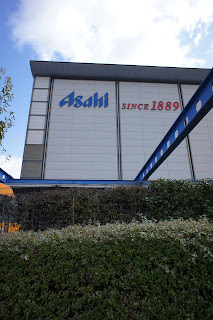

















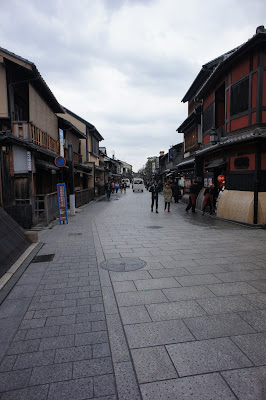




















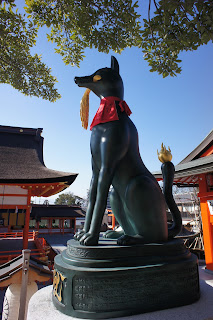
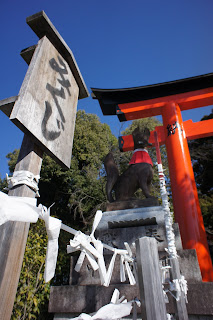






















































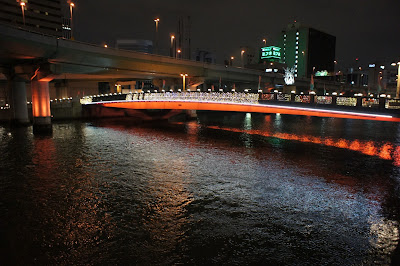


No comments:
Post a Comment